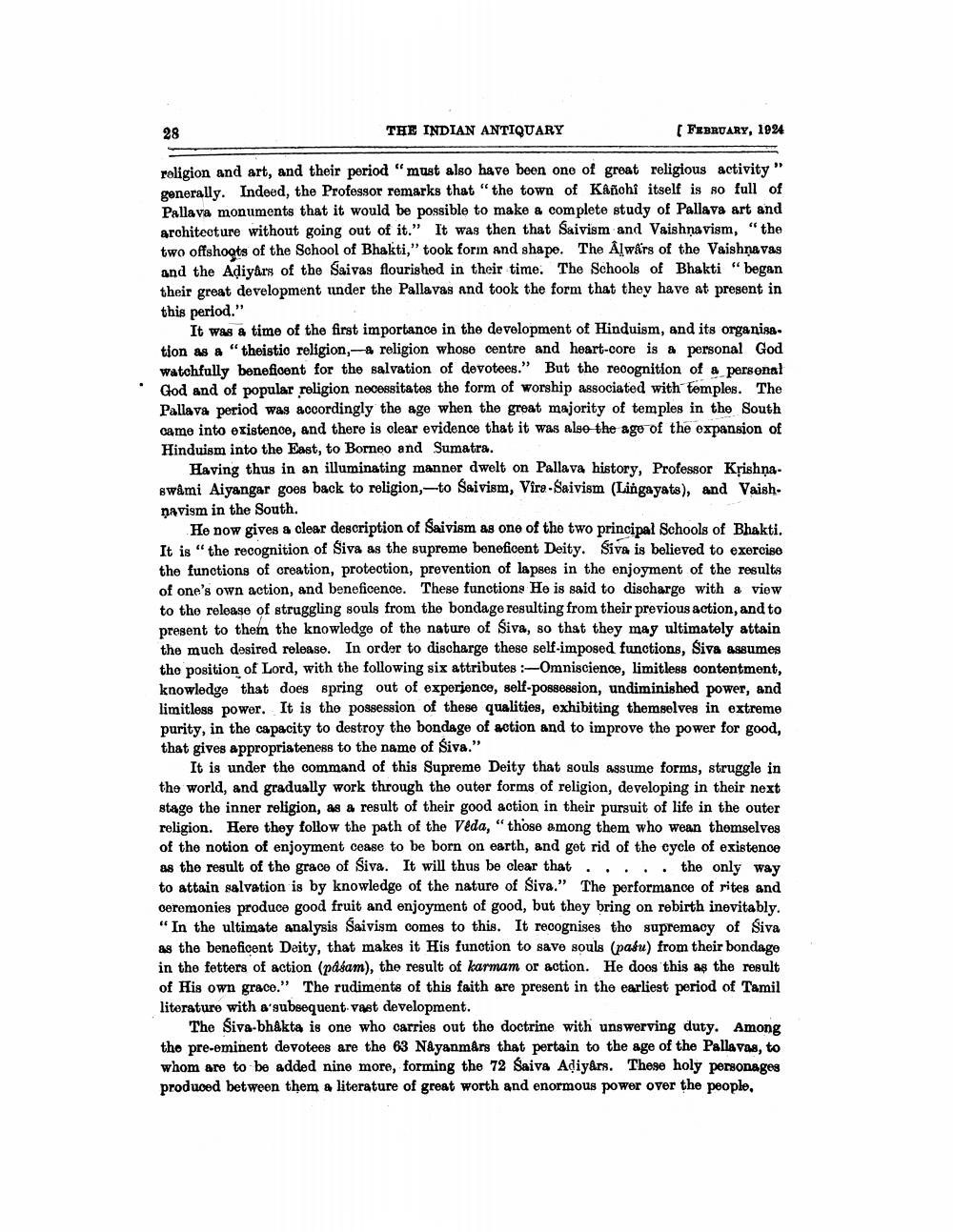________________
THE INDIAN ANTIQUARY
(FEBRUARY, 1994
religion and art, and their period "must also have been one of great religious activity" generally. Indeed, the Professor remarks that "the town of Kanohi itself is so full of Pallava monuments that it would be possible to make a complete study of Pallava art and architecture without going out of it." It was then that Saivism and Vaishnavism, "the two offshoots of the School of Bhakti," took form and shape. The Alwars of the Vaishnavas and the Adiyars of the Saivas flourished in their time. The Schools of Bhakti "began their great development under the Pallavas and took the form that they have at present in this period."
It was a time of the first importance in the development of Hinduism, and its organisa tion as a "theistio religion, religion whose centre and heart-core is a personal God watchfully beneficent for the salvation of devotees." But the recognition of a personal God and of popular religion necessitates the form of worship associated with temples. The Pallava period was accordingly the age when the great majority of temples in the South came into existence, and there is clear evidence that it was also the age of the expansion of Hinduism into the East, to Borneo and Sumatra.
Having thus in an illuminating manner dwelt on Pallava history, Professor Krishna - swami Aiyangar goes back to religion,--to Saivism, Vire-Saivism (Lingayats), and Vaish. ņa vism in the South,
He now gives a clear description of Saivism as one of the two principal Schools of Bhakti. It is "the recognition of Siva as the supreme beneficent Deity. Siva is believed to exercise the functions of creation, protection, prevention of lapses in the enjoyment of the results of one's own action, and beneficence. These functions He is said to discharge with a view to the release of struggling souls from the bondage resulting from their previous action, and to present to them the knowledge of the nature of Siva, so that they may ultimately attain the much desired release. In order to discharge these self-imposed functions, Siva assumes the position of Lord, with the following six attributes Omniscience, limitless contentment, knowledge that does spring out of experience, self-possession, undiminished power, and limitless power. It is the possession of these qualities, exhibiting themselves in extreme purity, in the capacity to destroy the bondage of action and to improve the power for good, that gives appropriateness to the name of Siva."
It is under the command of this Supreme Deity that souls assume forms, struggle in the world, and gradually work through the outer forms of religion, developing in their next stage the inner religion, as a result of their good action in their pursuit of life in the outer religion. Here they follow the path of the Veda, "those among them who wean themselves of the notion of enjoyment cease to be born on earth, and get rid of the cycle of existence as the result of the grace of Siva. It will thus be clear that .... the only way to attain salvation is by knowledge of the nature of Siva." The performance of rites and ceremonies produce good fruit and enjoyment of good, but they bring on rebirth inevitably. "In the ultimate analysis Saivism comes to this. It recognises tho supremacy of Siva as the beneficent Deity, that makes it His function to save souls (pasu) from their bondage in the fetters of action (pašam), the result of karmam or action. He doos this as the result of His own grace." The rudiments of this faith are present in the earliest period of Tamil literature with a subsequent vast development.
The Siva-bhakta is one who carries out the doctrine with unswerving duty. Among the pre-eminent devotees are the 63 Nayanmårs that pertain to the age of the Pallavas, to whom are to be added nine more, forming the 72 Saiva Adiyars. These holy personages produced between them a literature of great worth and enormous power over the people,




